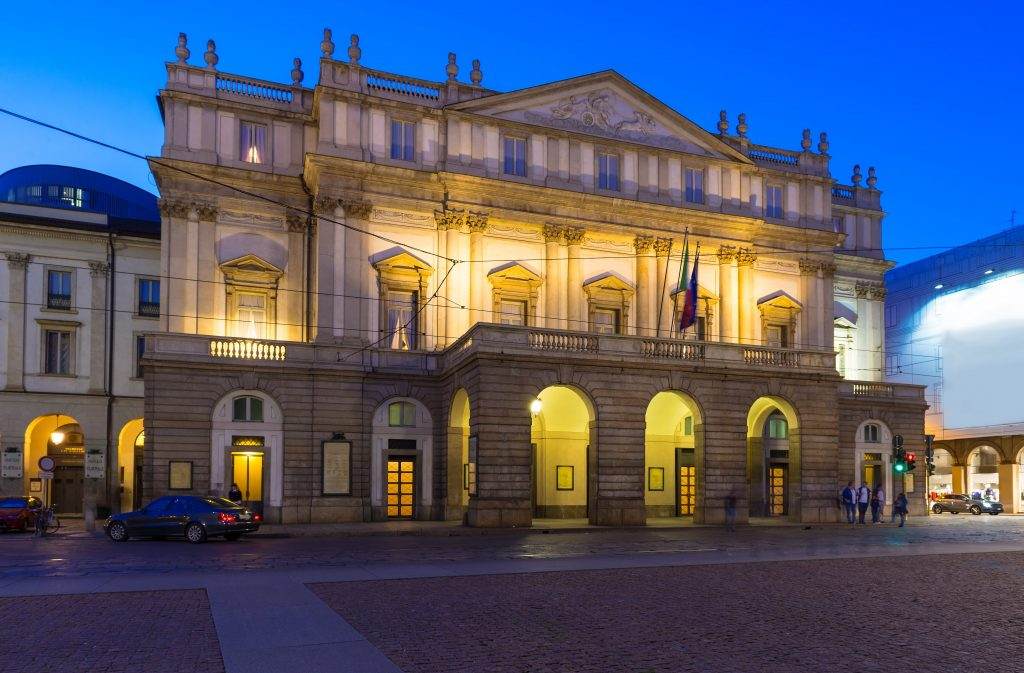27 Jan The history of the great theatres in Milan
Milan has a great theater culture. In effect, in the city there are some of the most important historical theatres of Italy, including Teatro alla Scala, the Piccolo Teatro, Teatro Manzoni, Teatro Dal Verme and Teatro Nuovo. Let’s discover together their history.
Teatro alla Scala
The Teatro alla Scala, also called “La Scala”, is the main opera house in the city of Milan and one of the most important in the world. The origin of this theatre dates back to the end of the 1770, when the church of Santa Maria alla Scala was demolished in order to make way for the new theatre, commissioned by the Austrian empress Maria Teresa. The project was consigned to the neoclassical architect Giuseppe Piermarini and the theatre was built in just two years.

The theatre was inaugurated in 1778 with the debut of the novel by Antonio Salieri: The Recognized Europe. At those times, the theatre was a popular and lyrical culture place. Another interesting fact is that the addition of the colonnade made by Piermarini was decided in order to divide the pedestrian line from the coaches line.
By the years, this theatre became one of the most important theatres in the world, hosting stars like Gioacchino Rossini, Giuseppe Verdi, Giacomo Puccini, Arturo Toscanini, Maria Callas, Herbert von Karajan and many more.
Il Piccolo Teatro
The Piccolo Teatro was founded in May 1974 by Giorgio Strehler, Paolo Grassi and Nina Vinchi, in order to offer quality shows to a wider audience, spreading to everyone the theatre culture. From 1991, in fact, it was named “teatro d’Europa”.
The theatre was renovated many times during the years, and one of those renovations took place in the cloister, after the discovery of some paintings in it, probably made by Bramante and Leonardo in the Fifteenth Century.
The power of this theatre during the years was the interdisciplinary nature of the shows, that includes ballets, prose and cinema festivals.
Teatro Manzoni
The Teatro Manzoni was founded in 1870 in Piazza San Fedele, initially named Teatro Sociale di Milano and then named after Alessandro Manzoni after his death in 1873.
The opening night was in 1881 with an opera by Emilio Usiglio. In 1943 the theatre was totally destroied by an air raid. It was re-opened in 1950 thanks to Alziro Bergonzo, who rebuilt it totally.
Teatro dal Verme
The Teatro dal Verme was inaugurated in 1872 and the building project was assigned to the architect Giuseppe Pestagalli by the Dal Verme family. Pestagalli took inspiration from the classical horseshoe shape typical of lyric theatres.
At Teatro dal Verme many lyrical stars, like Giacomo Puccini, appeared for their very first time. Even this theatre was destroyed by US air raids in 1943 and was re-built three years later, becoming a cinema.
Today, despite the actual use for exhibitions, conferences and cultural events, there is the will to maintain the hystoric charme of this theatre.
Teatro Nuovo
The Teatro Nuovo was born in 1938 by the project of the architect Lancia. From the beginning, the theatre standed out thanks to the high quality of the schedule that Remigio Paone, a close friend of Luigi Pirandello, managed to organize. At the Teatro Nuovo the most important theatre companies, such as Ruggero and Gramatica, De Sica-Melnati, and many more, made their debute.
After the outbreak of the war, the manager Paone escaped to Rome, where he stayed until 1945. Only after the war he went back to direct the Teatro Nuovo, making the theatre great again with the participation of: Totò, Wanda Osiris, Carlo Dapporto, Anna Magnani and many more.
After Paone’s death, the theatre was entrusted to the Milanese entrepreneur Franco Ghizzo, the person that began to propose the winning format of the musicals in the ‘80s.
These are only a few of the many great theatres in Milan, characterized by a historic heritage. If you love culture, theatre and history, you have to plan a visit in the city, and Hotel Cavour is ready to welcome you for an unforgettable stay.

